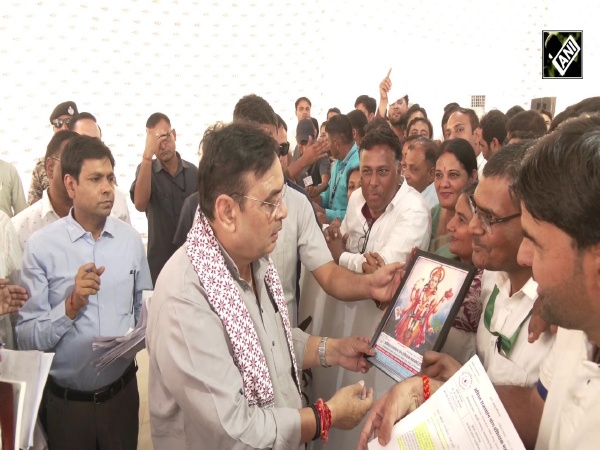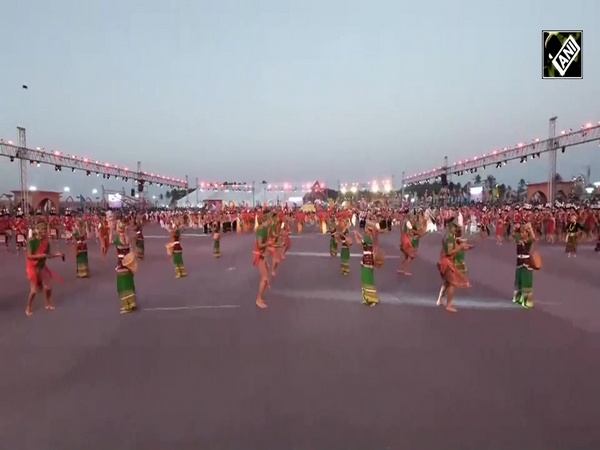Shortage of medical staff hits Nepal as third wave of COVID-19 sets in
Jan 20, 2022

Kathmandu [Nepal], January 21 : As the third wave of COVID-19 cases is raging across Nepal, the capital city of Kathmandu is witnessing long queues of front-line workers standing in line to get tested for COVID-19.
In less than a week, the Omicron variant has forced more than 500 doctors and health workers at various hospitals in capital Kathmandu alone to isolate, cutting them off from the duties.
"I think this third wave is going to bring a cry over the human resources because a lot of health care workers are getting infected with each passing day. The data from hospitals shows how hundreds of doctors and staff are getting infected with the virus. Once they have to go into isolation we won't be having an adequate number of health care workers to take care of the patients," said Dr. Lochan Karki, President of Nepal Medical Association in an interview with ANI.
The south Asian nation, with a population of 30 million, faced a shortage of necessary medical equipment in the first wave. While marching onto the second wave, the serious crunch of oxygen supply across the nation led to a spike in the death rate.
"In Nepal even before the COVID pandemic, the stock of several human resources was not up to the mark. Now during the pandemic, the gap between doctors and population has increased more as they are being rapidly infected and the resources remain the same," Dr. Karki said.
Already bearing the crunch of shortage of health workers at various departments inside the capital, the government has reduced the isolation time period to 5 days. Many of them are being treated at home isolation and the hospital.
Given the current state of affairs, the government has extended the tenure of contracted health workers maximum by three months from mid-January as per the requirement of the hospital. Moreover, the government has pledged to provide incentives to front-line workers working on the front taking up the risk which was introduced since the first wave but barely put out into practice.
Some regional and district hospitals outside Kathmandu Valley have been hit hard with the surging case of infection amongst health care workers. Many districts outside Kathmandu such as Charikot of Dolakha have been reported to halt some of its services as it doesn't have adequate staff to look after the patients after the majority of the staff tested positive for the contagion.
Similarly, the Bharatpur Hospital in Chitwan District, considered as one of the prime locations hosting large numbers of doctors and medical students, also has been quarantining the majority of its staff.
Despite reeling through two deadly waves, Nepal still remains unprepared for the third wave. In wake of rising infection, health workers themselves are adopting preventive measures to keep the contagion at bay.
"We should understand the major precaution we have to take as being a front line worker is like wearing the mask and at least we can use pile one mask over other as cases are increasing rapidly. Wash the hands more frequently which should be the first precaution of all and stay off from crowded areas," Dr. Binay Yadav, one of the intern doctors at Bir Hospital in Kathmandu told ANI.
Shortage of enough doctors and medical workers at the time of the pandemic could cost Nepal more lives as it already has lost a significant number of such professionals in earlier waves.
Within the first twenty days of 2022, Nepal's active caseload has skyrocketed from less than five thousand to more than fifty thousand. As per data of the Ministry of Health and Population released on Thursday evening, Nepal currently has 57,328 active cases and a positivity rate standing around 45 per cent.
On Thursday alone, the Himalayan Nation sitting in the middle between two giant nations India and China registered a record number of 12,338 new cases, setting a record for the third consecutive day.
The government has projected that several fresh daily cases might go up as high as 20 thousand cases in a single day as it marches towards the peak and then falls down. On Thursday, Kathmandu Valley registered more than half of the confirmed cases out of which Kathmandu registered 5,001 cases, Bhaktapur recorded 850 and Lalitpur recorded 1,130 cases.
According to the Ministry of Health and Population, there were four coronavirus-related deaths reported in the past 24 hours. With this, the COVID-19 death toll in the country is 11,632 to date.
Keeping in mind the current situation, the Nepali government earlier this week has started an inoculation drive for doctors, nurses, paramedics, lab technicians, hospital staff, and ambulance drivers with booster doses owing to the risk that lies ahead of them in their line of duty.
The booster doses also would be administered to journalists, bureaucrats, lawmakers, those serving in diplomatic missions, financial institutions, prisoners, and elderly people at old age homes and refugees who were vaccinated in the first phase of the immunization campaign starting January 27.
The Ministry of Health and Population also has decided to administer a third dose to all people above 60 years, inoculated six months ago as well as to those with compromised immunity from January 28.



















